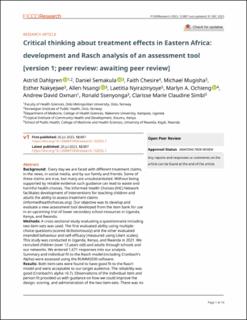| dc.contributor.author | Dahlgren, Astrid | |
| dc.contributor.author | Semakula, Daniel | |
| dc.contributor.author | Chesire, Faith | |
| dc.contributor.author | Mugisha, Michael | |
| dc.contributor.author | Nakyejwe, Esther | |
| dc.contributor.author | Nsangi, Allen | |
| dc.contributor.author | Nyirazinyoye, Laetitia | |
| dc.contributor.author | Ochieng, Marlyn A. | |
| dc.contributor.author | Oxman, Andrew David | |
| dc.contributor.author | Ssenyonga, Ronald | |
| dc.contributor.author | Simbi, Clarisse Marie Claudine | |
| dc.date.accessioned | 2024-03-07T06:55:50Z | |
| dc.date.available | 2024-03-07T06:55:50Z | |
| dc.date.created | 2024-03-06T10:47:08Z | |
| dc.date.issued | 2023 | |
| dc.identifier.citation | F1000 Research. 2023, 12 1-14. | en_US |
| dc.identifier.issn | 2046-1402 | |
| dc.identifier.uri | https://hdl.handle.net/11250/3121351 | |
| dc.description.abstract | Background: Every day we are faced with different treatment claims,
in the news, in social media, and by our family and friends. Some of
these claims are true, but many are unsubstantiated. Without being
supported by reliable evidence such guidance can lead to waste and
harmful health choices. The Informed Health Choices (IHC) Network
facilitates development of interventions for teaching children and
adults the ability to assess treatment claims
(informedhealthchoices.org). Our objective was to develop and
evaluate a new assessment tool developed from the item bank for use
in an upcoming trial of lower secondary school resources in Uganda,
Kenya, and Rwanda.
Methods: A cross-sectional study evaluating a questionnaire including
two item-sets was used. The first evaluated ability using multiple-
choice questions (scored dichotomously) and the other evaluated
intended behaviour and self-efficacy (measured using Likert scales).
This study was conducted in Uganda, Kenya, and Rwanda in 2021. We
recruited children (over 12 years old) and adults through schools and
our networks. We entered 1,671 responses into our analysis.
Summary and individual fit to the Rasch model (including Cronbach’s
Alpha) were assessed using the RUMM2030 software.
Results: Both item-sets were found to have good fit to the Rasch
model and were acceptable to our target audience. The reliability was
good (Cronbach’s alpha >0.7). Observations of the individual item and
person fit provided us with guidance on how we could improve the
design, scoring, and administration of the two item-sets. There was no local dependency in either of the item-sets, and both item-sets were
found to have acceptable unidimensionality.
Conclusion: To our knowledge, this is the first instrument validated
for measuring ability to assess treatment claims in Uganda, Kenya and
Rwanda. Overall, the two item-sets were found to have satisfactory
measurement properties. | en_US |
| dc.language.iso | eng | en_US |
| dc.rights | Navngivelse 4.0 Internasjonal | * |
| dc.rights.uri | http://creativecommons.org/licenses/by/4.0/deed.no | * |
| dc.title | Critical thinking about treatment effects in Eastern Africa: development and Rasch analysis of an assessment tool | en_US |
| dc.type | Peer reviewed | en_US |
| dc.type | Journal article | en_US |
| dc.description.version | publishedVersion | en_US |
| cristin.ispublished | true | |
| cristin.fulltext | original | |
| cristin.qualitycode | 1 | |
| dc.identifier.doi | 10.12688/f1000research.132052.1 | |
| dc.identifier.cristin | 2252319 | |
| dc.source.journal | F1000 Research | en_US |
| dc.source.volume | 12 | en_US |
| dc.source.pagenumber | 1-14 | en_US |
| dc.relation.project | Norges forskningsråd: 284683 | en_US |

